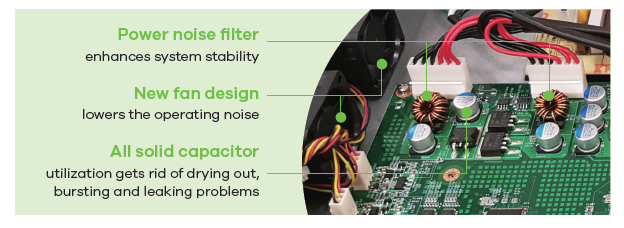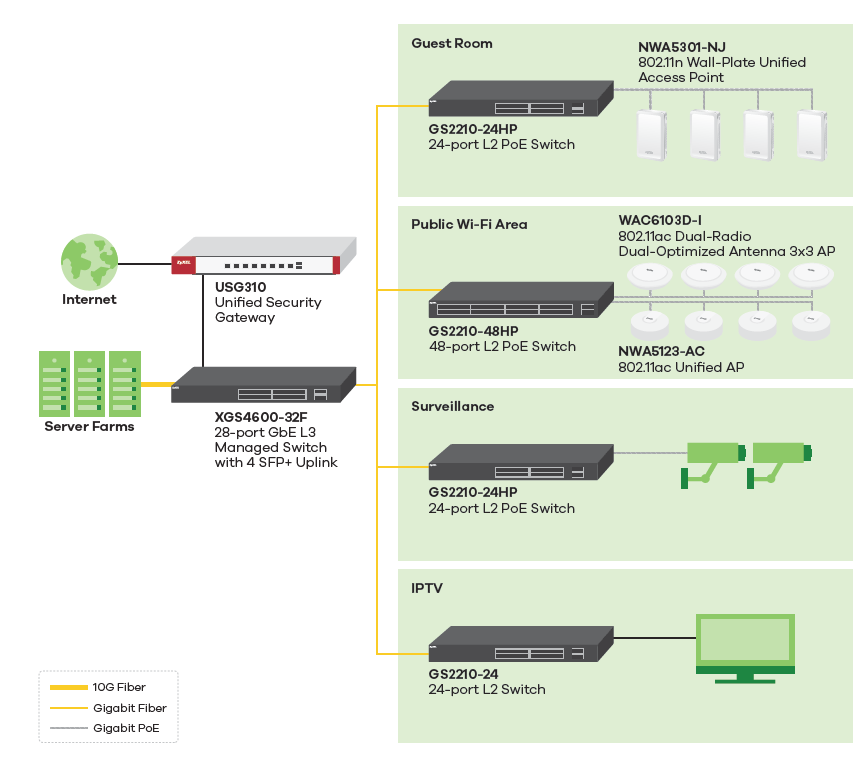Overview:
Bandwidth-intensive applications such as multimedia streaming, VoIP and video surveillance are used daily in business networks for more efficient workflows. However, the networks could be overloaded and that causes reduced business productivity. Deploying 10-Gigabit Ethernet ports at the aggregation layer to deal with bandwidth-intensive networks becomes the top choice of users such as hospitality venues and education institutions. Zyxel’s brand new Layer-3 stackable XGS4600 Switch Series comes with Gigabit connectivity and four integrated 10-Gigabit SFP+ slots that enable high-speed uplink connections for affordable, reliable network elements. The front panel with carbon fiber look brings a totally fresh look than traditional switches. Under the elegant hood, the XGS4600 Series not only features advanced L2 switching functionality, but also L3 routing capabilities for communications between networks.
- New ID design with carbon fiber look name plate delivers the modern look-and-feel in the closet
- Four built-in 10G SFP+ uplinks enable congestion-free, smooth data delivery for highbandwidth applications
- Provides high-bandwidth with true physical stacking of up to 4 units and 112 Gigabit ports
- High resiliency with redundant power supply units
Benefits:
High availability
To implement fault-tolerant networks, the Zyxel XGS4600 Series allows creating a physical stack through one or two 10-Gigabit SFP+ slots. Four units or 112 Gigabit ports can be configured as a stack using optional directattach cables or transceivers to provide high bandwidth on the XGS4600 Series for more flexible management. The stacking topology under the ring architecture provides high redundancy in case one of the stacking links fail. The system can quickly recover through another stacking connection. The XGS4600 Series is designed to support active-standby power redundancy to trigger backup power supply to take over in case the main power supply fails.
Advanced L3 features
Hierarchical business networks become more complex because of the increased communication among subnets. The XGS4600 Series features dynamic routing to simplify cross-subnet communications for businesses such as hospitality venues and education institutions that operate complex networks. In addition, the XGS4600 Series comes with full Layer-2 switching and Layer-3 routing capabilities if the system is working under the stacking mode. The stackable structure greatly enlarges network coverage as well as network resiliency that most enterprise networks require.
Flexible management and future-proof networks
The XGS4600 Series can be managed via CLI which is consistent with Zyxel managed switches, while the intuitive Web-based GUI helps skilled network administrators to quickly become more productive. As the IP address scheme evolves to accommodate a growing number of network devices, the Zyxel XGS4600 Series assures businesses a smooth migration path from IPv4-based networks to a full IPv6 infrastructure for protection to the investments in future network upgrades.
Model List
XGS4600-32 28-port GbE L3 Managed Switch with 4 SFP+ Uplink
- 24 x GbE RJ-45 ports
4 x GbE combo (RJ-45/SFP) ports
- 4 x 10 GbE SFP+ slots
XGS4600-32F 28-port GbE L3 Managed Switch with 4 SFP+ Uplink
- 24 x GbE SFP slots
- 4 x GbE combo (RJ-45/SFP) ports
- 4 x 10 GbE SFP+ slots
Robust Hardware
High-quality hardware design ensures stability and longevity for XGS4600 Series on your networks.

Features:
Standard Compliance
- IEEE 802.3 10Base-T Ethernet
- IEEE 802.3u 100Base-Tx Ethernet
- IEEE 802.3ab 1000Base-T Ethernet
- IEEE 802.3z 1000 Base-X
- IEEE 802.3x flow control
- IEEE 802.3az EEE support
- IEEE 802.1p CoS support
- IEEE 802.1D Spanning Tree Protocol (STP)
- IEEE 802.1w Rapid Spanning Tree Protocol (RSTP)
- IEEE 802.1s Multiple Spanning Tree Protocol (MSTP)
- IEEE 802.1Q VLAN tagging
- IEEE 802.1X Port authentication
- IEEE 802.3ad LACP aggregation
Traffic Management and QoS
- Rate limiting: policy-based/port- based bandwidth control with 64 kbps granularity
- Two Rate Three Color Marker (trTCM)
- CIR/PIR bandwidth control
- Port-based egress traffic shaping
- Broadcast storm control
- IEEE 802.1p with 8 priority queues per port
- WFR, WRR, SPQ scheduling algorithms
- DSCP/DSCP to 802.1p priority mapping
- IGMP/IGMP snooping v1, v2, v3
- IGMP throttling
- IGMP snooping fast leave
- IGMP snooping statistics
- Multicast VLAN Registration (MVR)
- Congestion control on all ports
- Selective Q-in-Q
IP Routing
- IPv4
- Wire-speed IP forwarding
- RIP v1, v2
- OSPF
- Static routing
- DHCP server/relay
- OSPF summary address
- DVMRP
- ECMP
- IP port moving
- VRRP IPv6
- IPv6 over Ethernet
- IPv6 addressing
- ICMPv6
- Dual Stack
- IPv6 static routing
- Neighbor discovery
- DHCPv6 relay
Link Aggregation
- IEEE 802.3ad LACP link aggregation
- Static port trunking
- Up to 16 aggregation groups, 8 ports per group randomly selected
- Link aggregation algorithm of source/destination IP address
Resiliency
- IEEE 802.1D Spanning Tree Protocol (STP)
- IEEE 802.1w Rapid Spanning Tree Protocol (RSTP)
- IEEE 802.1s Multiple Spanning Tree Protocol (MSTP)
- Equal Cost Multipath Routing (ECMP)
- Virtual Router Redundancy Protocol (VRRP)
- CPU protection
User Security and Authentication
- IEEE 802.1Q tag-based and port- based VLAN
- GVRP automatic VLAN member registration
- Up to 4 K static/dynamic VLANs
- Full range 4 K PVID support
- Port-based VLAN and VLAN isolation
- IP classification VLAN
- VLAN counter
- VLAN search
- VLAN translation
- VLAN MAC limit
- Intrusion lock
- MAC freeze
- MAC search
- MAC filtering
- Port security
- Limited MAC number per port
- IP source guard
- Loop guard
- IP filtering
- TCP/UDP socket filtering
- BPDU transparency
- IEEE 802.1X port-based authentication
- Enhanced 802.1X compensation assignment over VLAN
- TACACS+
- Layer 2 protocol tunneling
- Guest VLAN
Network Administration Security
- Username/password required for Web/Telnet/local console administrators
- Two-level security by specific SNMP read/write community
- Multiple login sessions
- Multiple access permission
- SSH v1, v2
- SSL/TLS
Network Management
- Zyxel iStacking™, up to 24 switches managed by a single IP address
- Physical stacking up to 4 switches
- Web-based management
- Telnet
- SSH
- SNMP v1, v2c, v3
- RS-232c local console
- IP management: static IP or DHCP- assigned IP
- Four RMON groups 1, 2, 3, 9 (history, statistics, alarms and events)
- Port mirroring: ingress/egress/both port mirroring
- IEEE 802.1AB LLDP
- Transceiver DDMI information (including MIB)
- sFlow
Intelligent ACL (L2/L3/L4)
- Based on MAC address
- Based on VLAN
- Based on IP address
- Based on protocol type
- Based on TCP/UDP type
- Based on DSCP
MIB Information
- RFC 1066 TCP/IP-based MIB
- RFC 1213, 1157 SNMPv2c/v3 MIB
- RFC 2011, 2012, 2013 SNMPv2 MIB
- RFC 1493 bridge MIB
- RFC 2674 bridge MIB extension
- RFC 1643 Ethernet MIB
- RFC 2358 Ethernet-like MIB
- RFC 1757 RMON group 1, 2, 3, 9
- RFC 2819, 2925 remote management MIB
- RFC4293 – Management MIB for IP
- Zyxel private MIB
Certifications
Safety
- ANSI/UL 60950-1
- CSA 60950-1
- EN 60950-1
- IEC 60950-1
EMC
- FCC Part 15 (Class A)
- CE EMC (Class A)
Zyxel One Network
ZON Utility
- iscovery of Zyxel switches, APs and gateways
- Centralized and batch configurations
- IP configuration
- IP renew
- Device factory reset
- Device reboot
- Device locating
- Web GUI access
- Password configuration
- One-click quick association with Zyxel AP Configurator (ZAC)
Smart Connect
- Discover neighboring devices
- One-click remote management access to the neighboring Zyxel devices
- Reset neighboring devices remotely to factory defaults
- Power cycle neighboring powered devices (PoE switches only)
Warranty
- Limited life-time warranty Warranty terms, service availability, and service response times may vary from country or region to country or region.
Documentation:
Download the Zyxel XGS4600 Series Datasheet (PDF).




